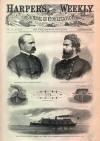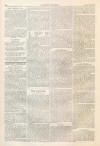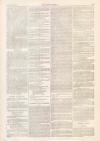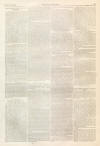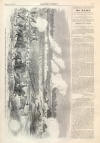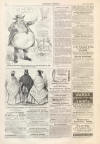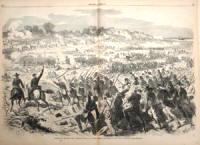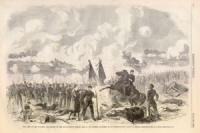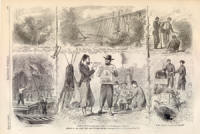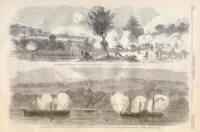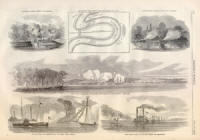|
This Site:
Civil War
Civil War Overview
Civil War 1861
Civil War 1862
Civil War 1863
Civil War 1864
Civil War 1865
Civil War Battles
Confederate Generals
Union Generals
Confederate History
Robert E. Lee
Civil War Medicine
Lincoln Assassination
Slavery
Site Search
Civil War Links
Civil War Art
Mexican War
Republic of Texas
Indians
Winslow Homer
Thomas Nast
Mathew Brady
Western Art
Civil War Gifts
Robert E. Lee Portrait
|
BRIGADIER-GENERAL TRUMAN
SEYMOUR.
IT gives us real pleasure to
publish, on page 465, a portrait of our old and valued correspondent General
Truman Seymour, whose sketches are familiar to the readers of this journal, and
whose distinguished gallantry at the battles before
Richmond have elicited such universal
admiration.
General Seymour was born at
Albany, New York, about the year 1827, and
entered West Point in 1842, graduating in 1846. He went to Mexico to join the
army under
General Scott, and at the battle of Cerro Gordo
won the brevet rank of First Lieutenant. At the attack on Contreras he and
Lieutenant (now General) Brannan led the van of the attacking army. At the close
of the war Lieutenant Seymour spent some years as military instructor of
drawing: we can testify that he was admirably qualified for the post. After a
brief campaign against Billy Bowlegs in Florida, he resumed the dull routine of
garrison duty, and, at the outbreak of the rebellion, found himself with
Major Anderson at
Fort Sumter. He was one of the most heroic and
gallant of that brave little garrison, and came out of the fort in very bad
health in consequence of his sufferings. He was soon afterward brevetted Major,
and appointed Brigadier-General of Volunteers. At the late fights before
Richmond he commanded a brigade in
McCall's Division, consisting of four regiments
of the Pennsylvania Reserve, and won imperishable glory. We are permitted to
make the following extracts from private letters front him to a friend:
BELOW RICHMOND, Night of July 1,
1862.
MY DEAR—: You will be glad to get
even this line from me, though I don't know how you will get it. We are on the
James River, and a gun-boat can carry a mail. The evening is clear, and the
distant sound of heavy cannonading has just ceased, in pursuit of a flying foe,
and after a magnificent battle scene. The Union cause is not hopeless now,
although it seemed so last night. We have had the hardest kind of fighting. This
of to-night is the fourth battle. In three of them my brigade played a not
inferior part. At Mechanicsville, on our right flank, our division alone held
40,000 men at bay for twelve hours, and when compelled tc withdraw, did so in
such a manner as to have elicited the high praise of the army. Reynolds and
myself can claim all the glory of the fight, for we alone commanded. I had two
horses shot under me. The next day, in the afternoon, the battle of Gainsville
was fought—25,000 against nearly 50,000—De Hart wounded, Easton killed, Reynolds
prisoner, etc. My escapes were wonderful, and will form the theme of much future
story. I led five regiments into the heavy fight besides my own brigade, and on
these two days I lost four hundred men in my command. Well, two days afterward
(yesterday), while folding up our right wing to fall back on the
James River, we had a great fight along the
whole line, where we barely held our own. My horse was shot in five places and
my clothes have six musket holes through them, but the skin not broken. By the
mercy of God alone have I escaped when many others were killed. I was reported
to have been killed.
Meade was wounded and McCall either killed or
captured. The division was nearly destroyed. One regiment of 800 men has lost
all but 50; and it is reduced now from 8000 down to about 3000 men, of which I
am in command.
Well, we can not go to Richmond
just now—the rebels have been much too strong for us. The skill with which this
last movement has been made will be admired by the world for ages, and must
place
McClellan very high as an able man.
All this while we have had
nothing to eat but hard bread and a little pork; we destroyed much of our
baggage; we carried nothing but our eatables in our pockets; for five nights I
have scarcely closed my eyes; but tonight, after a grand victory and a good cup
of coffee, and with every thing seeming to promise well if the country will only
support us, I shall sleep enough to make it all up and be ready for a fight
to-morrow.
WEDNESDAY, July 2, 1862—4 P.M.
Arrived this morning early at
Robinson's Landing, marching 17 miles by dark, starting at 12 o'clock. It has
rained all day—the ground is very soft; in this field, a plantation, the whole
army is concentrated; the river is full of transports; troops are arriving—a few
days' rest and we shall start again for Richmond. After being wet and hungry all
day I feel glad that my wagons have come up and that my night's rest is secure,
if the enemy does not attack, as he should do if he means to annihilate us. But
who can tell what is in store for us? I trust I shall be able to do my duty at
least as well as I have done. Today I have eaten nothing but wheat from the
field, and am wet and worn with watching and care, and you will know when you
see this how much a man can suffer and live. Nothing in all my life has met the
suffering of these days, my Fort Sumter trials included. May God bless our
cause, and give us yet more strength to endure! The army is full of heart, and
only asks a fair field and that God will be with us.
GENERAL BUTTERFIELD.
IN the dark days of April, 1861,
when the capital was in danger and the existence of the Government doubtful, one
of the earliest if not the first to hasten to Washington with a tender of his
services was
DANIEL BUTTERFIELD, commanding the Twelfth
Regiment New York Militia, whose portrait we give on
page 465. He found an attack momentarily
expected, and an organization of visitors and citizens hastily formed, known as
the Clay Guard, for the protection of the city from the hard-riding and
hard-drinking cavaliers promised for its "subjugation" by "Wise the Witless."
Colonel Butterfield enrolled himself at once, and many senators, judges,
lawyers, and distinguished citizens who served as privates in the ranks of the
Clay Guard on the memorable nights of the 17th and 18th of April will remember
him in the young orderly-sergeant who drilled them, and watch his career with
additional interest as a commander on a larger field. While engaged in this
sacred duty Colonel Butterfield had obtained the permission of the Secretary of
War to reorganize, fill up, and report his regiment at Washington on the 26th,
prepared for duty. With this order Colonel Butterfield made his way through
Baltimore, wet with the gore of Northern citizens shed by "plug uglydom" turned
"secesh" in its mad frenzy, and over broken bridges and torn up tracks arrived
in New York on Thursday night of the 20th, filled up his regiment (like most of
our militia organizations then merely a skeleton) from some 350 to 1000 men, and
left with them on Sunday afternoon in the Baltic, bound for Washington, by the
way of Fortress Monroe, looking to a passage up the Potomac; and then, by
information there obtained, to Annapolis. Assigned to the army corps of
Patterson, the Twelfth saw their hopes of active service disappear in dreary
marches and countermarches over
the "sacred soil," while
Bull Run was being fought and the vanity of the
South in arms supplied with material for boasting. In Patterson's division
General Butterfield (then Lieutenant-Colonel of the Twelfth United States
Infantry by a recent appointment) commanded a brigade, and sought for permission
to lead it into action. Soon afterward he received the full appointment of
Brigadier in an unsolicited and gratifying manner. During the autumn and winter
General Butterfield was profoundly occupied in drilling and disciplining his
brigade and converting them into those "stolid mudsill veterans" so much
deprecated by the South.
In the movement before Yorktown
General Fitz-John Porter's command was always
prominently engaged, and generally in the advance. Butterfield's brigade made
the first reconnoissance to
Big Bethel and Harold's Mill, and was with
Porter when he made his first approaches and
attack on Yorktown. On the 11th of April a
portion of the brigade repulsed a sortie of the enemy, receiving high encomiums
from General Porter. At the
battle of Hanover on the first sound of firing
General Butterfield left his sick bed for the saddle, and on receiving the order
to advance, pushed his Brigade forward in two lines: Lansing's Seventeenth New
York and M'Lane's Eighty-third Pennsylvania in the first, and Weeks's Twelfth
New York and Stockton's Sixteenth Michigan in the second, these last in double
column in the rear. Knowing from the heavy tiring in the front that he was
wanted, Butterfield pushed on on the double quick. With skirmishers thrown out
they dashed through the woods, halting on its edge for a moment only to dress
their line and reconnoitre the enemy, and then pushed forward into the
wheat-field adjoining in splendid style, driving the enemy before them. Here the
Seventeenth New York captured one of the enemy's guns, a brass 12-pounder.
Pushing on in the same order, they occupied the station of the Baltimore and
Ohio Railroad and Hanover Court-house, which had never witnessed so much
activity since its bricks were brought from England in 1735. At the Court-house
the news reached them that the enemy had reappeared in their rear and threatened
the left flank. This was met by General Porter with great promptness and
success. General Martindale gallantly met and sustained this attack with the
Second Maine, the Forty-fourth New York, a fragment of the Twenty-Fifth New
York. and a section of Martin's Battery. This was one or the severest contested
tights of the whole war, the enemy coming up boldly to the work, and showing
themselves in a comparatively open field. They had at the outset three gallant
New Yorkers to deal with in Generals Porter, Morrell, and Martindale, and a
fourth was on his way—for Butterfield, led by the sound of the firing, was
double-quicking back his weary men to the relief of one of his regiments
(Stryker's New York Forty-fourth), which was already warmly engaged supporting a
section of Martin's Battery, and arriving on the field with the Eighty-third
Pennsylvania on the enemy's flank, poured in a murderous fire, and the combined
forces soon sent the enemy "skedaddling." Again at the battles of
Mechanicsville and
Gaines's Mills General Butterfield won glory by
his skill and bravery. The Prince de Joinville was so struck by his gallantry
that he presented him with a horse in token of his regard.
THE ARMY OF THE POTOMAC.
WE continue in this number our
series of engravings of the battles before Richmond. On
page 470 we
reproduce a sketch by Mr. A. R. Waud, representing the
BATTLE OF BEAVER CREEK,
where McCall's division, in Fitz-John
Porter's corps, was attacked on 26th by an overwhelming force of rebels. We gave
an account of the battle in our last number. Mr. Waud says: "This battle was
fought by McCall's division, Thursday, June 26. The enemy having made a bridge
below Mechanicsville, with a view to passing the swamp and cutting off McCall's
command from the rest of the army, that General withdrew his forces across
Beaver Creek. Here the rebels attacked him, the fight lasting till after dark,
when, having repulsed the enemy, McCall fell back still further, in pursuance of
McClellan's plan of drawing his right wing across the Chickahominy, and taking
the
James River for the base of operations." We
will add the following description of the country from the Tribune
correspondence:
The battle was fought in dense
woods. Our forces were posted on the south side of a belt of forest on a line
nearly two miles long, the general course of which was nearly parallel with the
Chickahominy. The woods vary in depth from 40
to 100 rods; a small stream flows the entire length, and the ascent on either
side is quite sharp. Cultivated fields cover the brow and crest of the hills on
either side and in the right rear of our position extend half a mile to the
bottom land of the Chickahominy. On the left the fringe of woods reaches to this
bottom land. At 11 A.M., when I reached the field, our pickets occupied the top
of the hill across the ravine along its whole winding length. They reported a
battery of the enemy at Gainer's House, a mile north in his left rear, and
numbers of rebel, in distinct view. This battery soon exchanged shots with guns
on our right. Half an hour later they saluted our left with an occasional shell
from a position so far westerly as to enfilade our line. Meanwhile, an
occasional report from a sharp-shooter's rifle warned of the enemy's approach.
The fire of our batteries on the right gradually grew more rapid, but the day
wore away until it was 3 P.M., and there had been few casualties. Would the
enemy make a serious demonstration? A volley from one company of a regiment on
the left, directed at as many of the enemy who appeared on the crest of the
opposite hill, causing them to hurry back, did not answer the question
conclusively, for it was followed by dead silence. Twenty minutes later the
answer came, and it was unmistakable—it was a tornado of musketry.
The ball opened with the centre,
but only a moment, and the tornado swept right and left as if one current of
electricity had discharged every man's musket. Our men disappeared, sending back
cheerful shouts as they rushed into that dense wood where now corpses are thick
as the trees. A spatter of rebel lead lifted little puffs of dust on the hill
from which, with straining eyes, I in vain sought to penetrate those dark
recesses. A dull, heavy undercurrent of murmur as of the swarming of bees, the
sharp ring of a random Stinks overhead, the incessant roar of musketry, and now
the wounded and the dead being borne out of the jaws of death.
ON
page 468 we
reproduce Mr. Waud's sketch of the
BATTLE OF THE CHICKAHOMINY,
which was fought on Friday, 27th.
We have already described this fight, and will only add Mr. Waud's account of
it: "The next day the rebels in great force attacked M'Call again, now sustained
by Porter's division,
Slocum's division, and Sykes's brigade of
regulars, and part of Sumner's command. These sustained an unequal and bloody
fight with the rebel hosts till nightfall, when they were withdrawn across the
Chickahominy, blowing up the fine bridges which our engineers had built in their
rear. Our sketch represents Sykes's brigade standing firm before the rebel
efforts to overwhelm our lines. Beyond Sykes's, on the right, was McCall's and
Franklin's; but the smoke was so heavy that it was difficult to see much of the
field at once. The heavy smoke beyond was caused by the destruction of
commissary stores by fire, to prevent them falling into the hands of the enemy."
On
page 477 will be found another
picture, also from a sketch by Mr. Waud, illustrating the
fought on Saturday, 28th. Mr.
Waud writes:
"On Saturday the wagon trains
were gradually got to the rear, and our lines remained comparatively free from
attack. Before daylight Sunday morning our troops were withdrawn, the First
Massachusetts battery being the last to leave the outposts. Covering the trains,
Franklin's troops passed across the railroad at Savage's Station. The rebels
mistaking the movement for a retreat, came on with a spirit destined to be badly
checked—first near Fairoaks Station and then at Savage's—when, notwithstanding
that they attacked our troops before they had had time to form, they received a
fierce repulse, the Irish brigade acting particularly well.
"The picture represents the
troops forming along the railroad at Savage's Station, the rebels in the
distance, pressing on their infantry covered by a heavy fire of artillery—the
Union soldiers double-quicking into position."
BATTLE OF MALVERN HILL,
where the enemy attacked General
McClellan on the afternoon of Tuesday, July 1. The General, anticipating the
attack, had placed his cannon on a height in three rows of fifty pieces each,
each row falling back when the pieces became heated. It was the fire of these
pieces which so terribly decimated the army under Magruder. In our picture the
reader will remark that the rebels are in the fore-ground, and the Union
artillery in the background. The following account of the battle we take from
the Herald:
The ground is for the most part
open and undulating, presenting a splendid position for a battle-field. After
the fight of the previous day, further to the front, our artily fell back during
the night and took up the most eligible position the country afforded, with it
was enabled on Tuesday night to fall back still further to Harrison's Landing.
In the morning, anticipating a vigorous pursuit by the enemy, General McClellan
himself established tine lines of his army, and personally placed his troops in
position, prepared to meet the attack. The line formed a magnificent semicircle.
General Keyes was on the extreme right, with a portion of his command. General
Franklin's corps joined Keyes's left, and next in order from right to left were
placed Summer's corps, consisting of Richardson's and Sedgwick's division; Heintzelman's corps, embracing Hooker's and
Kearney's divisions; next General
Couch's division, which was detached from Keyes's command; while General
FitzJohn Porter's corps, consisting of General Morell's division and the
regulars, formed the extreme left. The configuration of the country rendered the
left almost certainly secure; for the lowlands beneath were completely commanded
by our artillery and the gun-boats. The right, however, was not so secure, and
that was the reason the position was found to be untenable afterward. The enemy
did not get his pursuing troops in position until the afternoon. For several
hours heavy cannonading was kept up on both sides—our ponderous siege guns,
which were ranged in a splendid position near the centre of our lines, pouring
destructive volleys into the columns of the enemy as they were being brought
forward and formed into line. After the artillery on both sides opened in the
afternoon, the shot and shell filled the air, and a most terrific cannonading
was kept up, with intervals, for hours. About half past three o'clock the
enemy's skirmishers advanced near our centre, and the opposing lines in front of
General Couch's position were soon hotly engaged. In this attempt to break our
lines the enemy signally failed. He was speedily driven back at the point of the
bayonet, and lost several colors, which we captured.
Later in the afternoon the enemy
brought out three light batteries, posted them near some barns in a wheat-field,
and opened a fierce fire on the same portion of our line. Several of our
batteries in Hooker's and Kearney's divisions immediately returned the fire, and
soon silenced those of the enemy. It was nearly sundown when the enemy made
another attempt to pierce our lines in front of General Porter's and Couch's
positions. A terrible cannonade was opened, and, simultaneously, heavy lines of
rebels were pushed to the front under cover of the artillery. Our troops met
them in the next gallant style, and the battle raged fiercely for two hours or
more, the tide gradually sweeping round from left to right. Heavy columns had
been seen in the afternoon bearing to our right, and apprehensions were
entertained that the enemy might burst out in that direction; but happily those
painful apprehensions were not realized. The rebels hurled their forces,
however, with fearful fury against our lines. General Couch, who had immediate
command of that portion of the line, in the most gallant manner planted the
colors of his regiment where he wanted them, and inspired his soldiers with
confidence. No troops fought more bravely than those engaged in this battle.
After the firing was running round to the right, General Porter sent to General
Sumner for reinforcements, and several regiments, including the Irish brigade,
were sent. This bold brigade, headed by the intrepid General Meagher, arrived in
front in time to render the most signal service. Lieutenant-Colonel Burke, of
the Sixty-third New York, is among the wounded. During the engagement it was a
magnificent sight to see, amidst the bursting shells, infantry, artillery, and
cavalry moving inside the semicircle, with remarkable celerity, to different
parts of the field. General McClellan, accompanied by a portion of his staff,
rode along the field, and was loudly cheered by our troops. In this battle,
which closed soon after darkness set in, the rebels did not gain one inch of
ground. We drove them back at every point with fearful loss. Where our artillery
opened with grape and canister the killed and wounded rebels were actually piled
upon each other. Several rebel regiments then came out in defiant line of battle
were terribly cut up. The battle was brief, but bloody. The rebel loss must have
amounted to several thousand. It is impossible to accurately estimate our own,
as circumstances compelled us to leave many on the field. It is believed,
however, that one thousand will more than cover it.
On
page 470 we illustrate the
performance of THE GUN-BOATS "GALENA" AND "MAHASKA" during the fight of 1st. Our
picture is from the pencil of an officer on board one of our vessels. He writes:
"Having cleared the James River
up to
Fort Darling and the obstructions, the
gun-boats, on account of the high banks and their inability to operate or occupy
far inland, have been obliged to hold merely what they had attained, to await
the co-operation of the army. On Tuesday Let the latter, having been two days in
its retreat, had come out on the James River. Here, at a point near Turkey
Island, our rear-guard were enabled to make a stand, being most effectually
covered in their retreat by the gun-boats. Here the enemy were twice repulsed
and several pieces of artillery taken, the shells from the 9-inch Columbiads,
and 100-pounder rifled guns of the boats, after a flight of frequently two or
three miles, dropping and exploding in the midst of the enemy's lines. Our shots
were mostly directed by signals made from the top of the house in the middle of
the background, and answered from our top-mast by an officer of the army signal
corps."
On
page 469, we
reproduce a sketch by our artist, Mr. Waud, representing
SCENES OF CAMP LIFE
before the late movement from the
Chickahominy to the James River. Mr. Waud writes:
"No. 1 represents the Railroad
from West Point to Richmond, at or about the locality where it leaves our lines,
some six miles from the city. It is a single track road, but it is an immense
convenience to the army in transporting the large supplies necessary for such an
enormous body of men. The scenery, without being at all striking, is very
picturesque along the road, the wild camps of our soldiers adding a great deal
of interest to it. Once or twice a rebel locomotive has made its appearance on
the track, skedaddling very quick when our guns opened on it.
"No. 2 is the Trestle-work over
the Chickahominy Swamp, about seven hundred yards in breadth at this point.
"No. 3 is a sketch of Sick and
Wounded Soldiers on their way to the White House, refreshing themselves at a
pure spring of water by the side of the railroad while waiting for the cars.
"No. 4 gives a good idea of the
pleasures of bridge-building in the swamp, where the atmosphere is very close,
and it is necessary for some of the builders to stand up to their middle in
water, while others cut and carry the logs to construct the bridge with.
"No. 5. Along some parts of the
line quite a good feeling exists among the pickets. By mutual consent they do
not fire, and the rebels leave their arms and join our men in a cup of coffee,
exchanging Richmond papers for the New York papers, and making themselves
generally agreeable. Picket-firing is not considered a humane business in modern
warfare; yet it is open to doubt whether the existence of a good understanding
may not have its evils on the other hand: neither can it be considered expedient
that the rebels should have recent copies of Northern papers.
THE
BOMBARDMENT OF VICKSBURG.
WE devote
page 476 to
illustrations of the ATTACK ON VICKSBURG, Mississippi, and to the engineering
device by which General Butler is going to make Vicksburg an inland-town. Some
of our sketches are by Dr. Henry, of the Navy, others by our special artist, Mr.
Theodore R. Davis. Mr. Davis writes:
"July 2. NEAR VICKSBURG.
"I arrived here yesterday with
the fleet of Commodore Davis, which is composed of the iron-clads Benton,
Carondolet, Louisville, and Cincinnati, with a number of rams; we found that
Farragut had run the batteries with the greater portion of his fleet, and found
that, though capable of driving the rebels from their guns, he could not keep
the town, which is somewhat knocked to pieces by this time. The town is situated
in the bend of the river, and just now our men are busy cutting a canal through
the neck of land, which will have the effect of ruining the city, as it will be
the means of changing the course of the river. This the people have been fearful
of for some time, for by so doing Vicksburg is soon left an inland town forever.
The river soon permanently changes its course. 1n order to prevent this the
railroad was built, for the law prevents the cutting a railroad.
"I went across the short neck of
land, and on board the Octorora saw Porter and Brown. Grant is expected to be
down here by land in five days, when it is intended to take a few secesh that
may be about Vicksburg. Porter thinks Mobile is ours when we want it. The shells
front his mortar-boats are thrown wonderfully, one every now and then right into
the rebel batteries.
"The secesh tried to capture some
of the mortar-schooners.
"Commodore Porter's mortar fleet
lying just off it on the Vicksburg side and close to the bend, induced a belief
among the rebels that they could board the vessels, and by one grand stroke gain
possession of them, also defeating any inferior number of troops opposed to
them. To accomplish this General Van Dorn marched a brigade from their
encampment and cautiously through the woods approached our vessels. When two
hundred yards distant the rebels made a charge, but were received by terrific
storms of grape that drove their back in confusion. They retired completely
defeated."
|
